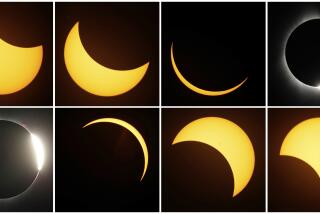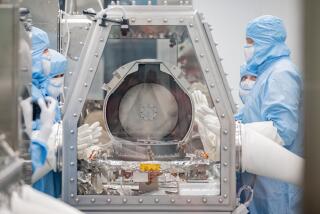Saturn’s Phoebe ring is huge -- and invisible to the human eye
Saturn’s biggest ring just broke its own record. Scientists have found that the planet’s Phoebe ring is more than twice the thickness once thought – even though it can’t be seen with the human eye.
The study, published in the journal Nature, also finds that this oversized ring is made mostly of tiny particles. The findings could shed fresh light on the evolution of the Saturnian ring system.
“I was giving talks saying Saturn has a giant invisible ring, which makes you sound just perfectly crazy,” said lead author Douglas Hamilton, a planetary scientist at the University of Maryland, College Park. “It is 10 to 20 times larger than the second-biggest ring, so this thing is absolutely gargantuan.”
Many of Saturn’s rings seem to hug the planet, forming the beautiful striped disc for which the gas giant is so well known. But in 2009, NASA’s infrared-sensing Spitzer Space Telescope picked up another ring so large that the entire planet and its main rings appear as a small dot in the middle.
The ring is difficult to detect in visible light (NASA’s Cassini spacecraft did so a few years later), but it can be clearly seen as a ghostly halo at infrared wavelengths.
Hamilton and colleagues first went looking for this “giant invisible ring” because of the strange two-tone coloring of Iapetus, one of Saturn’s moons. One side is pale, but the other side of the moon is dark, as if covered with soot. The scientists theorized that unseen particles from farther out were hitting Iapetus and blackening one side. (Iapetus is tidally locked with Saturn and can’t rotate fast enough to get an all-around coating.)
“If that material was coming inward and coating the face of Iapetus, then maybe we could see the ring,” Hamilton said, and the team started searching. “Usually those things don’t pay off, but this one did.”
At the time, they estimated that the ring stretched from 4.8 million to 7.76 million miles, though with Spitzer’s relatively narrow field of view, they couldn’t say how thick it really was.
Now, with NASA’s Wide-field Infrared Survey Explorer telescope, they have found that it stretches from about 3.75 million to 10.1 million miles – a little beyond Phoebe, a far-out moon that is the same color as the stuff in the ring, and is probably the source for the dark material.
While the Phoebe ring is enormous, the particles within are surprisingly tiny – the scientists estimate that the vast majority of them, roughly 90%, are smaller than the size of a soccer ball.
Understanding why the particle size distribution is so skewed could offer researchers “a window into the history of the Saturn system,” Hamilton said.
Follow @aminawrite for more science news.







